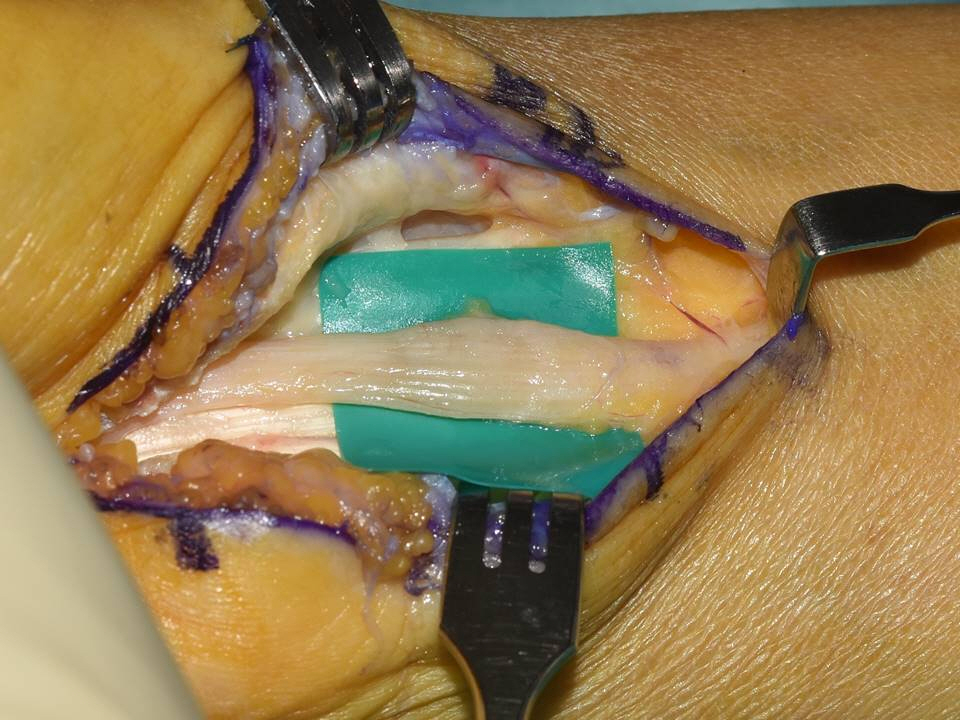Arch Hand Microsurg.
2022 Jun;27(2):187-192. 10.12790/ahm.21.0147.
Standard incision and median nerve external neurolysis for recalcitrant carpal tunnel syndrome
- Affiliations
-
- 1Department of Orthopedic Surgery, King Faisal University, Hofuf, Saudi Arabia
- 2Department of Orthopedic Surgery, Asan Medical Center, University of Ulsan College of Medicine, Seoul, Korea
- 3Department of Orthopedic Surgery, Gangneung Asan Hospital, University of Ulsan College of Medicine, Gangneung, Korea
- KMID: 2531927
- DOI: http://doi.org/10.12790/ahm.21.0147
Abstract
- Purpose
Failed carpal tunnel surgery poses a challenge for the attending surgeon(s). Numerous revision techniques have been reported in the literature, with evidence of long-term improvement. However, studies exploring how early could symptomatic improvement be detected are scarce. The objective of this study was to identify the speed of symptom(s) recovery after a repeated decompression technique using an open standard incision and median external nerve neurolysis with no supplemental procedures.
Methods
Nine patients who underwent revision carpal tunnel surgery involving standard incision, external median neurolysis, and no supplemental techniques between June 2017 and June 2020, were included. Data regarding the preoperative Boston Carpal Tunnel Syndrome Questionnaire (BCTQ) score, Disabilities of the Arm, Shoulder and Hand score, visual analogue score, and grip strength were collected and compared with evaluation results at 3 months postoperatively.
Results
In all patients, severe adhesion of the median nerve with the surrounding soft tissue was confirmed intraoperatively. Compared with preoperative findings, 3-month evaluation of patients demonstrated a statistically significant improvement in the BCTQ symptoms score and pain score. All nine patients were satisfied with the procedure.
Conclusion
Standard incision and median nerve external neurolysis can be a good option for recalcitrant carpal tunnel syndrome patient who has an adhesion of the median nerve with surrounding soft tissue.
Figure
Reference
-
References
1. Soltani AM, Allan BJ, Best MJ, Mir HS, Panthaki ZJ. A systematic review of the literature on the outcomes of treatment for recurrent and persistent carpal tunnel syndrome. Plast Reconstr Surg. 2013; 132:114–21.
Article2. Bland JD. Treatment of carpal tunnel syndrome. Muscle Nerve. 2007; 36:167–71.
Article3. Scholten RJ, Mink van der Molen A, Uitdehaag BM, Bouter LM, de Vet HC. Surgical treatment options for carpal tunnel syndrome. Cochrane Database Syst Rev. 2007; 2007:CD003905.
Article4. Shi Q, MacDermid JC. Is surgical intervention more effective than non-surgical treatment for carpal tunnel syndrome? A systematic review. J Orthop Surg Res. 2011; 6:17.
Article5. Verdugo RJ, Salinas RA, Castillo JL, Cea JG. Surgical versus non-surgical treatment for carpal tunnel syndrome. Cochrane Database Syst Rev. 2008; 2008:CD001552.
Article6. Zieske L, Ebersole GC, Davidge K, Fox I, Mackinnon SE. Revision carpal tunnel surgery: a 10-year review of intraoperative findings and outcomes. J Hand Surg Am. 2013; 38:1530–9.
Article7. Tung TH, Mackinnon SE. Secondary carpal tunnel surgery. Plast Reconstr Surg. 2001; 107:1830–43.
Article8. Lauder A, Mithani S, Leversedge FJ. Management of recalcitrant carpal tunnel syndrome. J Am Acad Orthop Surg. 2019; 27:551–62.
Article9. Beck JD, Brothers JG, Maloney PJ, Deegan JH, Tang X, Klena JC. Predicting the outcome of revision carpal tunnel release. J Hand Surg Am. 2012; 37:282–7.
Article10. Westenberg RF, Oflazoglu K, de Planque CA, Jupiter JB, Eberlin KR, Chen NC. Revision carpal tunnel release: risk factors and rate of secondary surgery. Plast Reconstr Surg. 2020; 145:1204–14.
Article11. Stirling P, Yeoman T, Duckworth AD, Clement ND, Jenkins PJ, McEachan JE. Decompression for recurrent carpal tunnel syndrome provides significant functional improvement and patient satisfaction. J Hand Surg Eur Vol. 2020; 45:250–4.
Article12. Djerbi I, César M, Lenoir H, Coulet B, Lazerges C, Chammas M. Revision surgery for recurrent and persistent carpal tunnel syndrome: clinical results and factors affecting outcomes. Chir Main. 2015; 34:312–7.
Article13. O'Malley MJ, Evanoff M, Terrono AL, Millender LH. Factors that determine reexploration treatment of carpal tunnel syndrome. J Hand Surg Am. 1992; 17:638–41.14. Aroori S, Spence RA. Carpal tunnel syndrome. Ulster Med J. 2008; 77:6–17.15. Levine DW, Simmons BP, Koris MJ, et al. A self-administered questionnaire for the assessment of severity of symptoms and functional status in carpal tunnel syndrome. J Bone Joint Surg Am. 1993; 75:1585–92.
Article16. Hudak PL, Amadio PC, Bombardier C. Development of an upper extremity outcome measure: the DASH (disabilities of the arm, shoulder and hand). The Upper Extremity Collaborative Group (UECG). Am J Ind Med. 1996; 29:602–8.17. Vernadakis AJ, Koch H, Mackinnon SE. Management of neuromas. Clin Plast Surg. 2003; 30:247–68.
Article18. Mathoulin C, Bahm J, Roukoz S. Pedicled hypothenar fat flap for median nerve coverage in recalcitrant carpal tunnel syndrome. Hand Surg. 2000; 5:33–40.
Article19. Murthy PG, Abzug JM, Jacoby SM, Culp RW. The tenosynovial flap for recalcitrant carpal tunnel syndrome. Tech Hand Up Extrem Surg. 2013; 17:84–6.
Article20. Varitimidis SE, Riano F, Vardakas DG, Sotereanos DG. Recurrent compressive neuropathy of the median nerve at the wrist: treatment with autogenous saphenous vein wrapping. J Hand Surg Br. 2000; 25:271–5.
Article21. Langloh ND, Linscheid RL. Recurrent and unrelieved carpal-tunnel syndrome. Clin Orthop Relat Res. 1972; 83:41–7.
Article22. Amadio PC. Interventions for recurrent/persistent carpal tunnel syndrome after carpal tunnel release. J Hand Surg Am. 2009; 34:1320–2.
Article23. Duclos L, Sokolow C. Management of true recurrent carpal tunnel syndrome: is it worthwhile to bring vascularized tissue? Chir Main. 1998; 17:113–7.
Article24. Katz JN, Fossel KK, Simmons BP, Swartz RA, Fossel AH, Koris MJ. Symptoms, functional status, and neuromuscular impairment following carpal tunnel release. J Hand Surg Am. 1995; 20:549–55.
Article25. Atroshi I, Larsson GU, Ornstein E, Hofer M, Johnsson R, Ranstam J. Outcomes of endoscopic surgery compared with open surgery for carpal tunnel syndrome among employed patients: randomised controlled trial. BMJ. 2006; 332:1473.
Article
- Full Text Links
- Actions
-
Cited
- CITED
-
- Close
- Share
- Similar articles
-
- Median Nerve Block for Treatment of Carpal Tunnel Syndrome: Report of 5 cases
- An Unusual Cause of Carpal Tunnel Syndrome: A Case of Tuberculosis of the Median Nerve
- The Results of Open Release in Carpal Tunnel Syndrome
- Carpal Tunnel Syndrome Caused by Lipofibromatous Hamartoma of the Median Nerve
- Median Nerve Injuries Caused by Carpal Tunnel Injections



